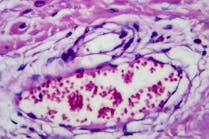A study published in Nature Communications shows that the drug rucaparib has been effective in treating certain types of ovarian cancers if used early in treatment, after a diagnosis, and before the cancer cells build up a resistance to chemotherapy, according to a news release from the University of Washington.
Rucaparib is in a relatively new class of drugs - Poly(ADP-ribose) polymerase or PARP inhibitors - which have been approved for therapy in ovarian cancers. This study provides insights into both how the cancers resist treatments, and which patients may respond favorably to the drug, said lead author Elizabeth Swisher, MD, UW Medicine Gynecologic Oncologist and Professor of Obstetrics and Gynecology at the University of Washington School of Medicine. She also co-directs the Breast and Ovarian Cancer Research Program at the Seattle Cancer Care Alliance.
The paper represents collaborative work of researchers in 75 universities and focuses on treatments of 493 patients between April 2013 and October 2016.
“PARP inhibitors are a drug class that has become an important therapeutic for ovarian and some other cancers. This study looked at pretreatment biopsies to define predictors of response to treatment and mechanisms of resistance (within the cancer cells), which is critical to understanding best use of these therapies,” Swisher said.
The best responders included those patients with ovarian cancer associated with inherited or somatic (not inherited) mutations in the ovarian cancer susceptibility genes BRCA1, BRCA2, RAD51C and RAD51D, all genes involved in DNA repair, Swisher noted.
The study found that cancers exposed to previous platinum chemotherapy have built up resistance by improving their DNA repair capabilities, which then creates cross-resistance to rucaparib. This explains why PARP inhibitors work better earlier in the course of treatment, Swisher said.
The researchers correlated many molecular alterations to response to treatment including inherited and somatic mutations, methylation alterations (epigenetic changes) and genomic scars (mutational patterns created by defective DNA repair).





